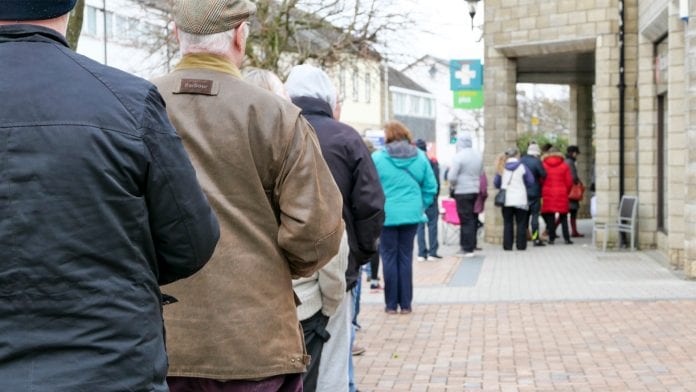
Jan De Belie, Professional Affairs Advisor at the Pharmaceutical Group of the European Union (PGEU), spoke to Health Europa Quarterly about how community pharmacies have been impacted by COVID-19 and the role they could now play in ensuring that vaccines can reach as many people as possible.
During the COVID-19 pandemic, the various and diverse elements of the healthcare sector have been under immense pressure. Much of this has been a result of the sheer number of virus cases – and, indeed, fatalities. Many other factors have also played a role in adding strain, from the panic buying of essential items to patients’ need – and often failure – to attend routine medical appointments. Pharmacies have been on the frontline of this, not least due to their remaining open to the public during the lockdown phases (and both before and after them).
As much of the world now seems to be recovering from the pandemic – at least from what may have been the first peak – community pharmacies face new challenges which are exacerbated by the fact that, in Europe at least, we are now moving towards the winter months which bring with them the flu season and numerous other healthcare-related issues. As such, and given that community pharmacists are recognised and supported within national health systems as key health professionals making a dynamic, sustainable, and evolving contribution to the health of the individuals and communities they serve, they will continue to have a fundamental role to play. One area of significance is the delivery of vaccines to the public. However, there will be challenges to overcome here, too, as many countries strive to ensure that flu vaccines and others are made available and accessible to those who need them.
As a part of our special focus on the importance of vaccines, compiled as a part of our Memorandum of Understanding with the Active Citizenship Network, Health Europa Quarterly spoke with Jan De Belie, Professional Affairs Advisor at the Pharmaceutical Group of the European Union (PGEU), about how pharmacies have been impacted by COVID-19 and how, moving forwards, they may be able to help in the delivery of not only additional flu vaccines, but also a COVID-19 vaccine when it becomes available.
How has COVID-19 impacted Europe’s community pharmacies?
The impact that most, if not all, sectors have experienced has been quite dynamic in that it has also been dependent on the onset of COVID-19, which occurred at different times in different places. In a general sense, from around March pharmacies have experienced the busiest times they have ever faced. We have seen an incredible overburdening in terms of workload, with some pharmacies seeing double the number of patients they would usually see. This was perhaps due, in the first instance, to the panic being generated by much of the media coverage – many countries saw citizens rushing to purchase items such as paracetamol and other medicines, as well as things like personal protective equipment (PPE) and hydroalcoholic hand gel. In addition to dramatically increasing the workload for pharmacies, this also presented a challenge as we worked to ensure the continuity of supply, particularly during the first few weeks of the pandemic. For instance, some pharmacists began to compound their own hydroalcoholic gel because supplies had run out so quickly.
Alongside this, lockdown measures were implemented relatively quickly in a number of countries; and pharmacies were one of the only public healthcare services to remain freely open to the public. This presented additional challenges – a shortage of PPE meant that pharmacy staff (and customers) were not as well protected as they could or should have been. Furthermore, the pandemic has presented a unique situation – no-one is used to taking social distancing measures, for instance – and so pharmacy staff and patients were once more placed at an enhanced level of risk as citizens slowly adjusted to the new rules and guidelines.
Nevertheless, things did get better with time, as people became more familiar with practices such as social distancing and wearing mouth and nose coverings in enclosed spaces. Pharmacies, along with many other establishments, implemented additional measures such as plastic screens, floor markings denoting the appropriate social distance, and limiting the number of people allowed inside the building at any one time. Many of these protective measures were introduced in the first instance by pharmacies in order to minimise the risk of infection, as people with COVID-19 symptoms continued to visit their local pharmacy.
Of course, it took some time for people to understand that if they were presenting with any COVID-19 symptoms then they should not be visiting the pharmacy, where they could infect other people, including the staff, but should instead be isolating. As a result of this, some pharmacy staff were infected with the coronavirus during the first few weeks of the pandemic, particularly in Spain and Italy, where the infection rates were especially high; and some pharmacists have lost their lives because of this.
After the first few weeks, we saw something of an inversion – as lockdown measures were implemented, fewer people were leaving their homes and so fewer people were also visiting pharmacies. After that, things gradually began to normalise and have now stabilised at a level close to what we experienced before the pandemic.
The overall use of healthcare services, however, is still being impacted by the coronavirus, particularly in terms of delays to the access of care. While this varies from country to country, the general sense is that many people remain concerned about the risk of being exposed to and infected with COVID-19; and are therefore avoiding attending healthcare settings for things like check-ups, vaccinations, and treatment for either ongoing conditions or new symptoms. Delaying care can be dangerous, and so pharmacists are now working with the other healthcare providers to continue to raise awareness around the fact that people should not delay their care and that the healthcare system can still manage these day-to-day activities in a safe manner.

To what extent is the provision of life-saving health interventions falling victim to efforts to address COVID-19? Given that community pharmacies are often seen as a knowledge hub where people can seek advice on healthcare matters, how have they been impacted by people seeking advice on the coronavirus?
People are always welcome in a pharmacy should they simply need health information. As such, while there was an increase in the number of people seeking such information from their local pharmacy, this was not seen as a burden – although, as we have already discussed, the sheer volume of pharmacy users was a challenge in a very general sense.
Pharmacies play a key role in the dissemination of health information. This is not limited to the advice we give to patients and customers, but also includes things like the posters we displayed in our windows explaining the different COVID-19 preventive measures, and so on.
However, it is important to highlight that during the pandemic pharmacies have seen a sharp rise in the number of patients visiting them with symptoms unrelated to COVID-19 (such as indications of possible cancer or cardiovascular issues), and for whom we have needed to make referrals. As such, this is an area that needs to be taken into consideration when developing strategies for the post-coronavirus world, in that we need to ensure that an adequate system is in place to link the diverse elements of the healthcare sector up so as to ensure that patients are effectively referred and that the communication between nodes can flow uninterrupted.
In terms of access to medications, pharmacies have expanded their home delivery services quite considerably as a result of the COVID-19 pandemic. This began to happen when lockdown measures were introduced and when patients with coronavirus symptoms were asked not to visit pharmacies: in some countries this was carried out in collaboration with, for instance, the Red Cross. But even as we begin to emerge from that in many places, it is a service that pharmacies are continuing to deliver at a much higher rate than before.
With regard to the management of shortages, in some countries the powers of pharmacists were expanded so that they better could better help patients, including expanding their legal competence to perform generic substitutions.
These are just some of the trends that we have seen emerge as a response from the pharmacy sector to ensure that essential medicines are still guaranteed to reach the patients who need them.

What has the sector learned from the pandemic, perhaps in terms of the use of technology and digitisation?
The importance of digital communication between the pharmacist and the patient and vice versa has certainly been underlined; as has the need to optimise communication between healthcare professionals. We have begun to see a very positive trend here in areas such as the digital transfer of prescriptions, particularly for repeat prescriptions for chronic medications, which has enabled patients to avoid multiple appointments with their GP. This is something we have witnessed taking place in many countries – the extent, however, has been very much dependent on the rules and laws in place in a particular country and whether there was an electronic prescription system already in place to allow physicians to print or send prescriptions directly to pharmacists.
Furthermore, some countries have also seen an increase in the digital transfer of vital patient information in the form of shared electronic healthcare records, subject to patient consent. In this area, many of the barriers that existed before COVID-19 were removed, where possible, and certainly this is a positive development as it enables pharmacists to provide better patient care.
Moving forwards, as countries begin to develop pandemic management and preparedness plans, the issues of delay and access to care need to be taken into consideration.
Have you seen any positive examples of how those issues are being managed in some countries?
Countries and their healthcare systems responded differently as the challenges each country has experienced differs from one to the next. Scotland is an interesting example: the government empowered community pharmacies by expanding the ‘minor ailment service’ in an effort to reduce the pressure being placed on other elements of the NHS. This became known as the ‘pharmacy first’ service, and was designed to encourage people to visit a pharmacy for common ailments in the first instance – pharmacists are trained to handle these conditions; and there are protocols in place for how pharmacists manage the care for such patients. Furthermore, pharmacists were also provided with increased access to emergency care summary data to enable them to manage these patients more effectively. Additional funding was allocated to pharmacists so that they could take on this extended role.
Elsewhere, in countries such as Portugal and Spain, for instance, where many patients were only able to access certain medications directly from hospitals, there was a change to the rules so that these patients could access their medications from pharmacies where appropriate.
During the pandemic, and particularly during those weeks where many places were locked down and so people remained at home for almost all of the time, there were significant concerns in a number of countries about a rise in domestic violence. As such, a number of countries such as France, Spain, Belgium, and the Netherlands developed a system in which they encouraged people to report domestic violence through pharmacies – because pharmacies, as we have already discussed, were one of the only healthcare services that had remained open. In most of those countries, a person can ask for a ‘mask 19’: this is not an actual product; it is a code phrase which informs the pharmacist that they need to trigger the necessary domestic violence protocol for that patient.
Some European countries are looking to strengthen and extend flu vaccination programmes before autumn in order to reach more people, while it is hoped that a COVID-19 vaccine will soon be developed. What additional challenges could arise from this?
The organisation of vaccination delivery services differs across Europe. For instance, when it comes to community pharmacists there are currently eight European countries – Denmark, France, Greece, Ireland, Norway, Portugal, Switzerland, and the UK – where community pharmacists are able to administer flu vaccinations. In these countries, this is complementary to other existing vaccination services. It is also clear that these countries have seen a positive impact of such services and this is in part due to the fact that they are available at the pharmacy level and are therefore much more widely accessible. In those countries where pharmacies are not allowed to administer such vaccines, they will typically have other important roles to play, such as acting as the main distribution or access point for the vaccine.
The role of pharmacies is also key in terms of identifying and reminding target groups, because we see so many people inside the pharmacy, not only those who are sick, or who have particular needs. Nevertheless, there is an increasing appetite in most European countries for a wider authorisation of pharmacists to actually be able to administer vaccines themselves.
It is important to note that any pharmacist who administers vaccines would have received the appropriate training, despite the argument used by some that this is not the case.
The Pharmaceutical Group of the European Union (PGEU) recently called on governments to make use of all available resources within their healthcare systems in order to ensure that vaccination delivery can be done both safely and to a high quality standard. Adequate accessibility, particularly in the context of COVID-19, will be crucial moving forwards; and so there needs to be an efficient approach. Once a COVID-19 vaccine becomes available, a significant section of the population will need to be vaccinated. To achieve that, we will need to make use of all the available services, including pharmacies which have already demonstrated that they can undertake this by administering vaccines such as those for flu, travel vaccines, pneumococcal vaccines, and so on, in many countries. This will therefore require the rollout of training programmes for pharmacists – particularly in countries where this is not already being practised – and, in some cases, a review of current legislation. As such, it is imperative that action towards these goals starts now.
The impact that a COVID-19 vaccine will have on pharmacies in Europe will depend on how governments make use of them, both in terms of possibly administering the vaccine but also potentially acting as distribution hubs.
In the USA, it has already been confirmed that the legislation will be changed to allow pharmacies to administer vaccines. In Europe, even in those countries where pharmacies are already able to administer some vaccines, there will also need to be regulatory changes so that the COVID-19 vaccine is included.
There will also need to be changes in terms of organisation. For instance, pharmacies in Ireland have been delivering flu vaccinations to patients for a number of years, and an appointment system for this is now being installed which has the potential to also be used for COVID-19 vaccines. This will go some way towards avoiding a potential situation in which a huge number of people all try to access a vaccine at the same time.
A system that prioritises at-risk groups must also be in place when the COVID-19 vaccine becomes available, as well as for the flu vaccine before the winter. This is something that is already being rolled out in countries like Belgium, which is set to provide the flu vaccine to at-risk groups in the first instance before providing it to the other parts of the population. This is certainly something that needs to be applied to the future COVID-19 vaccine, but for that to be successful there needs to be adequate preparation so that the right people can be channelled to the right place at the right time.

Vaccine hesitancy is a serious issue and one which is expected to worsen in the context of the future COVID-19 vaccine, in part due to the spread of misinformation, particularly on social media. How can this be tackled?
Vaccine hesitancy is indeed a potential major barrier to achieving significant coverage with the COVID-19 vaccine when it becomes available. The first prerequisite is an enhanced level of transparency, alongside excellent communication from public authorities and regulators on the regulatory process. It goes without saying that the development of this vaccine will be subject to the same rigorous processes and will need to meet the same standards as any other vaccine. However, the general public, who may not be as well-versed in this area as those who work in the healthcare sector, will perhaps require additional scientific reassurances on efficacy and safety before they agree to be vaccinated, particularly as a COVID-19 vaccine may reach the market much quicker than a traditional one, and so people may assume that steps have been missed.
Once this level of communication and transparency has been achieved, healthcare professionals – including pharmacists – will have a key role in supporting that message and in delivering it to patients.
PGEU is one of the co-chairs of the Coalition for Vaccination, a coalition of European associations of healthcare professionals and relevant student associations in the field. Through this, even before the coronavirus pandemic, we have been working to improve public confidence in vaccines, because vaccine hesitancy is unfortunately not a new thing. We are also working towards a campaign around flu vaccination addressing some of the concerns that have been raised by the vaccine hesitancy community.
This interview is part of an EU initiative focused on vaccination ideated by Cittadinanzattiva/Active Citizenship Network and realised in partnership with Health Europa Quarterly.

Jan De Belie
Professional Affairs Advisor
Pharmaceutical Group of the European Union (PGEU)
+32 (0) 2 238 08 18
j.de-belie@pgeu.eu
Tweet @PGEU
www.pgeu.eu
This article is from issue 15 of Health Europa. Click here to get your free subscription today.










